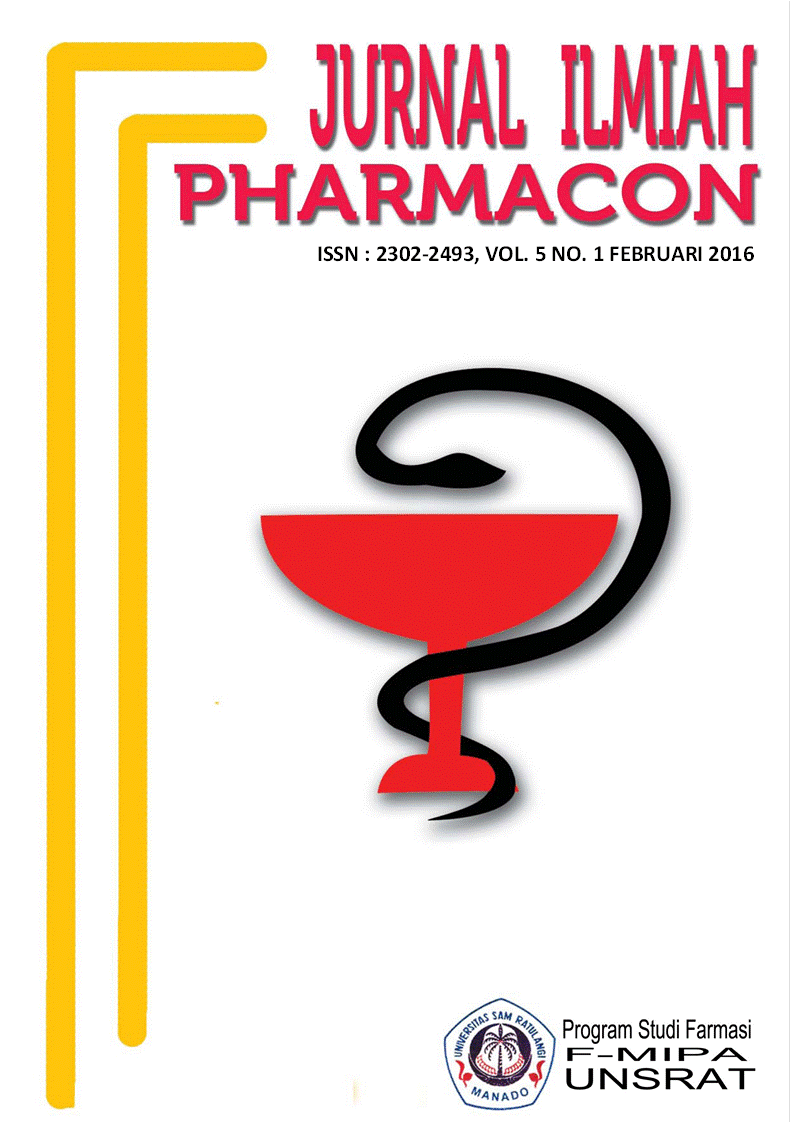HUBUNGAN ANTARA KONSUMSI MAKANAN DENGAN KEJADIAN HIPERTENSI DI DESA TANDENGAN SATU KECAMATAN ERIS KABUPATEN MINAHASA
DOI:
https://doi.org/10.35799/pha.5.2016.11345Abstract
HUBUNGAN ANTARA KONSUMSI MAKANAN DENGAN KEJADIAN HIPERTENSI DI DESA TANDENGAN SATU KECAMATAN ERIS KABUPATEN MINAHASA
Anggun A. Manawan1), A. J. M. Rattu1), Maureen I. Punuh1)
1)Fakultas Kesehatan Masyarakat Universitas Sam Ratulangi
Â
ABSTRACT
Hypertension is a manifestation of hemodynamic balance disorders of the cardiovascular system. Patients with hypertension rose from 600 million in 1980 to nearly 1 billion in 2008. Based on data Riskesdas 2013, an increase in the prevalence of hypertension is based on interviews of 9.5%. The next picture in the year 2013 by using individual analysis unit show that nationally 25.8% of Indonesian people suffering from hypertension. Based on data from Minahasa district health department in 2014, amounted to 32.910 cases of hypertensive disease, and resume the sub-district health profile of Eris in 2014, a percentage of the total hypertension reached 90.28%, this indicating that hypertension remains a major public health problem in the world. The study was observational analytic with cross sectional study. This research was conducted in the village of Tandengan The Minahasa District of Eris at 45-59-year-old community with a population of 265 people and which meet the criteria as much as 94 people. The prevalence of respondents with hypertension as much as 40.4%. Statistical test result p= 0.392, which means there is no relationship between carbohydrate intake with hypertension, p= 0.000, meaning that there is a relationship between fat intake with the incidence of hypertension and the relationship between sodium intake with hypertension, with p=0.000.
Key words: carbohydrate intake, fat intake, sodium intake, hypertension
ABSTRAK
Â
Hipertensi merupakan manifestasi gangguan keseimbangan hemodinamik sistem kardiovaskular. Penderita hipertensi meningkat dari 600 juta pada tahun 1980 menjadi hampir 1 miliar pada tahun 2008. Berdasarkan data Riskesdas 2013, terjadi peningkatan prevalensi hipertensi berdasarkan wawancara mencapai 9,5%. Selanjutnya gambaran di tahun 2013 dengan menggunakan unit analisis individu menunjukan bahwa secara nasional 25,8% masyarakat Indonesia menderita penyakit hipertensi. Berdasarkan data dinas kesehatan Kabupaten Minahasa tahun 2014, penyakit hipertensi berjumlah 32,910 kasus, dan resume profil kesehatan kecamatan Eris tahun 2014, presentase total hipertensi mencapai 90,28%, ini menunjukkkan bahwa hipertensi masih menjadi masalah utama kesehatan masyarakat di dunia. Jenis penelitian ini adalah analitik observasional dengan rancangan cross sectional study. Penelitian ini dilaksanakan di Desa Tandengan Satu Kecamatan Eris Kabupaten Minahasa pada masyarakat yang berumur 45-59 tahun dengan jumlah populasi 265 orang dan yang memenuhi kriteria sebanyak 94 orang. Prevalensi responden yang menderita hipertensi sebanyak 40,4%. Hasil uji statistik nilai p=0,392 yang artinya tidak terdapat hubungan antara asupan karbohidrat dengan kejadian hipertensi, p=0,000 artinya terdapat hubungan antara asupan lemak dengan kejadian hipertensi dan terdapat hubungan antara asupan natrium dengan kejadian hipertensi dengan nilai p=0,000.
Kata kunci : Asupan karbohidrat, asupan lemak, asupan natrium, hipertensi
Downloads
Published
How to Cite
Issue
Section
License
Authors who publish with this journal agree to the following terms:
- Authors retain copyright and grant the journal right of first publication with the work simultaneously licensed under a Creative Commons Attribution-NonCommercial 4.0 International License that allows others to share the work with an acknowledgement of the work's authorship and initial publication in this journal.
- Authors are permitted and encouraged to post their work online (e.g., in institutional repositories or on their website) prior to and during the submission process, as it can lead to productive exchanges, as well as earlier and greater citation of published work (See The Effect of Open Access)










